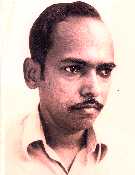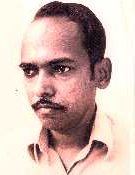

Home | Biodata | Biography | Photo Gallery | Publications | Tributes
Reviews

 |

Home | Biodata | Biography | Photo Gallery | Publications | Tributes Reviews |
 |
Census is any official count of population and recording of age, sex and economic status of individuals who are counted. Even though a nationwide census involves complete enumeration it could have an error rate of about one percent whether it be the U.S. census or the Indian census.
Once I tried to organize a complete enumeration of people belonging to the Narikorava tribe in Madras city. We had to plan it in such a way that no one was left out and no one was counted more than once. The problem was made difficult by the fact that the Narikoravas are a nomadic people and were constantly on the move. They would move their portable shelters every once in a while and they used to look down on those who had a permanent place for residence. Without knowing enough about their social practices it was difficult to draw up a schedule with proper categories regarding their income, marital status etc. I was able to realize the kind of limitations one should expect in the level of accuracy of the figures obtained every ten years in the Indian census.
For studying public opinion, or level of literacy, it is better to organize sample surveys instead of complete enumeration. One can estimate the level of accuracy in sample surveys and with a sample of a few thousand, one can keep the error rate down to one percent. If sample surveys were to be organized every year then definitional problems crop up. For example, one has to decide the number of categories into which one should divide a town or village, or the number of categories of occupation one should recognize. If deficiencies are recognized the following year in the manner of categorization then it is difficult to decide whether to continue the same categories year after year so that the figures are comparable, or to keep improving year by year even though inter-year comparisons become difficult. This kind of questions arise at the time of organizing any census, especially a national census like the Indian Census. In 1971, to find the proportion of literates, the entire population including new born babies were taken into account. This definition wiped out any gains made in the level of literacy.
The book under review was the outcome of a meeting of the Association for Asian Studies, held in New York in 1977. Scholars interested in Indian studies got together to discuss the value and the limitations of the census data of hundred years beginning with the census of 1871 of undivided India. The volume has a ten page introduction by the editor, Gerald Barrier, but has no index. The volume includes eight papers each one of them dealing with some social area of interest.
The first paper is by Daniel Moore and is entitled, "Plantation Labor in Mysore 187!-1941: A Historical Approach to Migration Analysis". The paper is concerned with the migration of labour to coffee estates in Mysore in the nineteenth and twentieth centuries. The author describes how the census data can be used to find answers to a defined research problem. The author makes use of the Census Report which is qualitative data, as well as the section on Tables. The section dealing with qualitative data is quite interesting. A statistical model is used to estimate the place of birth of plantation labourers and it is an interesting exercise. The main formula in p.26 has a misprint which makes the model difficult to follow .
This paper is followed by "Sources and Types of Census Errors" by Joseph Schwartzberg and ''Bibliographic Notes on the Indian Census" by Richard Martin.
This is followed by Kenneth Jones' paper, "Religious identity and the Indian Census''. It is an interesting paper which describes the way in which the Census evolved from neutral source of description of the religious categories of people and how the educated people who read the census reports reacted to the census figures. It describes the fears and anxieties of different religious communities and the stages which led to the creation of Pakistan. It also describes the fear of the majority community losing its members to Islam and Christianity and how the ceremony of shuddhi was used to reconvert people back to Hinduism.
Even though shuddhi is understood as a pureficatory ceremony the concept of pollution and its significance has not yet been fully understood. In ancient India objects were divided into different categories. To one category belonged
gold and silk which are not pollutable and these can be received as gifts. To the second belonged fire and
running water![]() cleansing agents which could remove pollution. To a third category belonged objects
that pollute, such as a dead body. Many other objects could get polluted by direct or indirect contact with a polluting substance but in most cases they could be purified.
Untouchability was used as a means of maintaining ritual purity, or in other words to avoid
pollutability. This ancient idea of pollution is still alive and has not been fully discussed in relation to the removal of untouchability in India.
cleansing agents which could remove pollution. To a third category belonged objects
that pollute, such as a dead body. Many other objects could get polluted by direct or indirect contact with a polluting substance but in most cases they could be purified.
Untouchability was used as a means of maintaining ritual purity, or in other words to avoid
pollutability. This ancient idea of pollution is still alive and has not been fully discussed in relation to the removal of untouchability in India.
The next paper is entitled, "The Census of India as a Source for the Historical-Study of Religion and Caste" by Frank Conlon. Data on religious affiliation of individuals are presented in the decennial census report of 1871-1971. Further classification of Christians and Muslims into sects and denominations were made. However finer classification of Hindus in terms of religious beliefs and practices could not be made. Caste data were collected up to 1941 but the most detailed caste-based classifications were made in the reports of the census of 1931. The report of the British in caste as a system which divided and ranked the Indians found an extensive response among the people of India. However after India became independent caste data were not collected except for the Scheduled Castes and Scheduled Tribes.
"Christians in the Census: Tanjore and Trichinopoly Districts, 1871-1901" is an interesting paper by Oddie. He demonstrates how census figures can be successfully used for the study of Christianity at the district level. The percentage of Christians in Tanjore district had been between three and four percent, and in Trichinopoly district between four and five percent. The study also compares the census figures with the data collected by the missions and shows that in both the districts, among the Christians those from the higher castes form a majority. Details about individual castes are also discussed in the paper.
The paper on "Caste and the British Census in Bihar: Using Old Data to Study Contemporary Political Behaviour" by Harry Blair tries to explain the political behaviour of the people of Bihar in terms of caste. The author had collected data on the caste identification of the MLA candidates and worked out the proportion of votes gathered by candidates of different castes, and tries to estimate the proportion of different castes among the voters on the basis of the census data of 1911. Statistical methods are made use of to arrive at the main findings.
The last paper is by Richard Newell and is entitled, "Census as a Tool in the Study of Modern Urban Labor Forces in India : A Case Study from Tamilnad". Data on Madras, Madurai, Coimbatore, Trichinopoly, Salem and Tanjore are taken up for analysis. It is shown that these cities experienced great demographic growth beginning life in the nineteenth century even before the introduction of mechanization in industry. This is a valuable paper and it illustrates how census data can be fruitfully put to use. The paper has three appendices with detailed tables and graphs.
The volume will be found useful by social scientists working on demography, urbanization and political science, who wish to make use of quantitative data and quantitative methods.